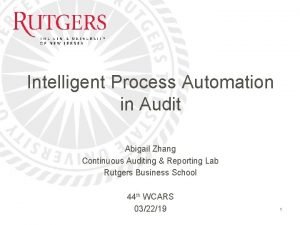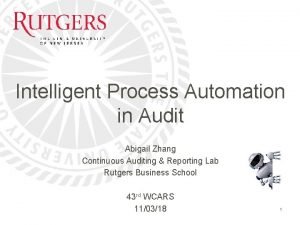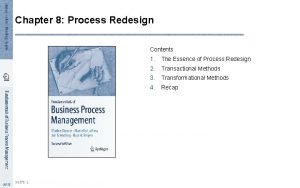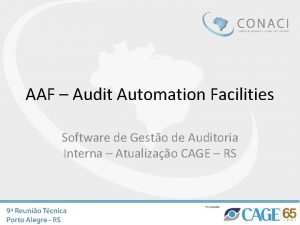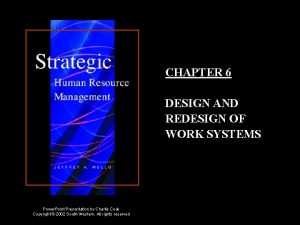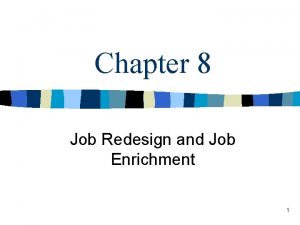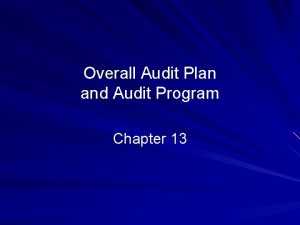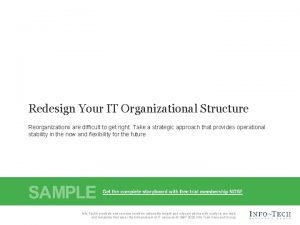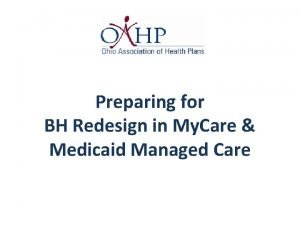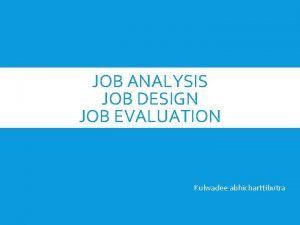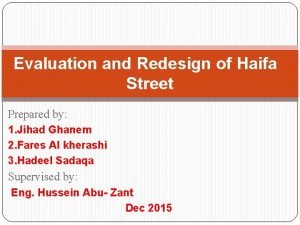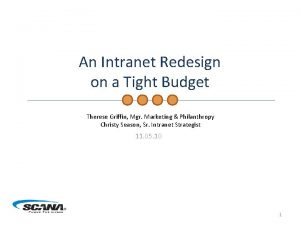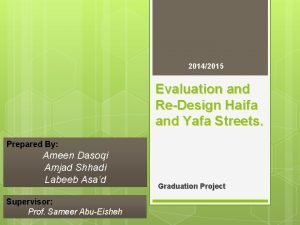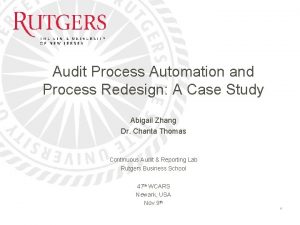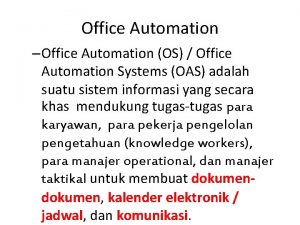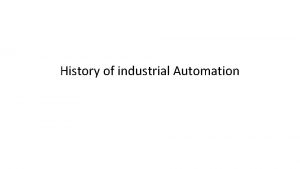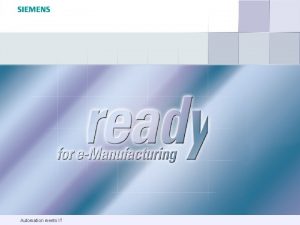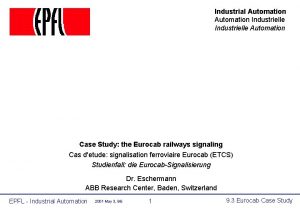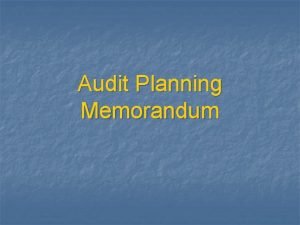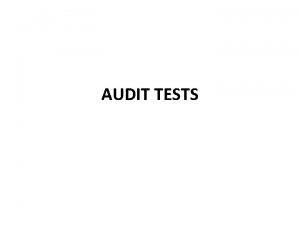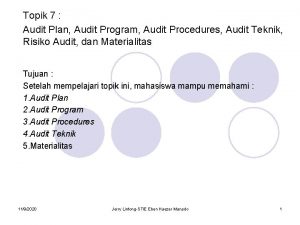Audit Process Automation and Process Redesign A Case

















- Slides: 17

Audit Process Automation and Process Redesign: A Case Study Abigail Zhang Dr. Chanta Thomas Continuous Audit & Reporting Lab Rutgers Business School 47 th WCARS Newark, USA Nov 9 th 1

Outline • Introduction • Case Background • The Original Audit Process • Audit Process Automation and Process Redesign • The RPA Prototype • Evaluation Measures • Limitations and Future Research • Conclusions 2

Introduction • “Although we did not observe the use of emerging technologies on audits inspected in 2018 — such as artificial intelligence and robotic process automation— we observed that audit firms are actively considering these technologies when developing their future software audit tools. ” (Staff Preview of 2018 Inspection Observations, PCAOB). • This is becoming more of a focus by regulatory agencies like the PCAOB and AICPA. • Call for research in understanding how these technologies will affect audit procedures and impact audit quality. 3

Introduction This study focuses on Robotic Process Automation (RPA) : • the process of a pilot development of RPA for a specific type of audit • how RPA can be integrated into the current audit methodology • how audit efficiency and effectiveness can be affected 4

Introduction Software 1 Software 5 Software 2 Robotic Process Automation (RPA) Software 4 Software 3 • Structured data • Rule-based processes • A single correct outcome (IEEE, 2017; Lacity and Willcocks, 2017) 5

Case Background Single Audits are audits of non-federal entities that expend $750, 000 or more of Federal funds in one year. A list of candidate tasks for automation in the audit planning phase. Observed 5 real audit engagements and documented the details of the steps. 6

The Original Audit Planning Process Schedule of Expenditures of Federal Awards (SEFA) (Excel document) Validate the integrity of the data by verifying the program title, name of the Federal grantor agency, CFDA number, and program cluster. Case. Ware document Decide SEFA-wide materiality

The Original Audit Planning Process 8

Observations of the Original Audit Process Intensive rulebased manual work Multiple-file interactions Error-prone procedures Timeconsuming procedures Nonstandardised annotations There is a need for process automation and redesign Good candidates for RPA 9

Audit Process Automation and Process Redesign • Identified rule-based and repetitive tasks Steps Rule-based tasks Pre-SEFA Testing Compare program information of CY SEFA with that of PY SEFA. Group programs that are in the same cluster and calculate the total expenditure for that cluster. Calculate the percentage change of the total expenditure from CY SEFA to PY SEFA Testing Planning Step 1 If the total expenditure per SEFA is above $750, 000, then choose “yes” for the first question. If the answer to the previous question is “Yes”, then choose “No” directly for the second question. 10

Audit Process Automation and Process Redesign • Identified rule-based and repetitive tasks Steps Planning Step 3 Rule-based tasks Input the amount of the total expenditure from the CY SEFA. Choose the range of amount to which the total expenditure belongs. Identify Type A and Type B programs. Count the number of Type A programs and low-risk Type A programs. Count the number of Type B programs and low-risk Type B programs. Calculate the sum of expenditures for all major programs and compare it with the corresponding portion of the total expenditure from CY SEFA. 11

Audit Process Automation and Process Redesign • Redesigned audit working papers – Standardized the unaudited SEFA file – Standardized other Excel format audit working papers – Reorganized the sequence of some audit tasks 12

The RPA Prototype End-to-end process automation for audit planning 13

Evaluation • Efficiency improvement – Originally, auditors generally spend around 3 hours performing the mundane, repetitive, and rule-based tasks in the audit planning procedure. – The RPA bot can finish the same task within 5 minutes. • Effectiveness improvement – Improved accuracy – Systemized rule-based audit tasks – Standardized some audit working papers – Auditors can spend more time on tasks that require professional judgements. 14

Limitations and Future Research Limitations: • Hard to obtain efficiency and effectiveness improvement measures from real audit engagements – External auditors are still conservative in adopting emerging technologies – The CPA firm lacks RPA talents to expand the RPA prototype Future Research • Challenges in adopting RPA in external audit • Potential risks of RPA adoption in external audit • The deployment model of RPA – Decentralized, or hybrid? • The cost and benefit analysis of using RPA in external audit 15

Conclusions • RPA has the potential to automate the mundane tasks in external audit • This case study focused on the process of RPA development for Single Audits and its impact on audit quality. • The initial evaluation measures show that the automated and redesigned audit procedure can enhance efficiency and effectiveness. 16

Thank you! Please contact me at: abigail. zhang@rutgers. edu 17
 Intelligent process automation in audit
Intelligent process automation in audit Continuous auditing workflow
Continuous auditing workflow Uscg bpr
Uscg bpr Process redesign principles
Process redesign principles The redesign orbit
The redesign orbit Best worst and average case
Best worst and average case Aaf audit automation facilities
Aaf audit automation facilities Design and redesign of work systems
Design and redesign of work systems Job redesign meaning
Job redesign meaning Audit definition
Audit definition Overall audit plan
Overall audit plan Quarter redesign
Quarter redesign Getting organizational redesign right
Getting organizational redesign right Bh redesign
Bh redesign Job analysis process
Job analysis process Redesign haifa
Redesign haifa Scina
Scina Redesign haifa
Redesign haifa
